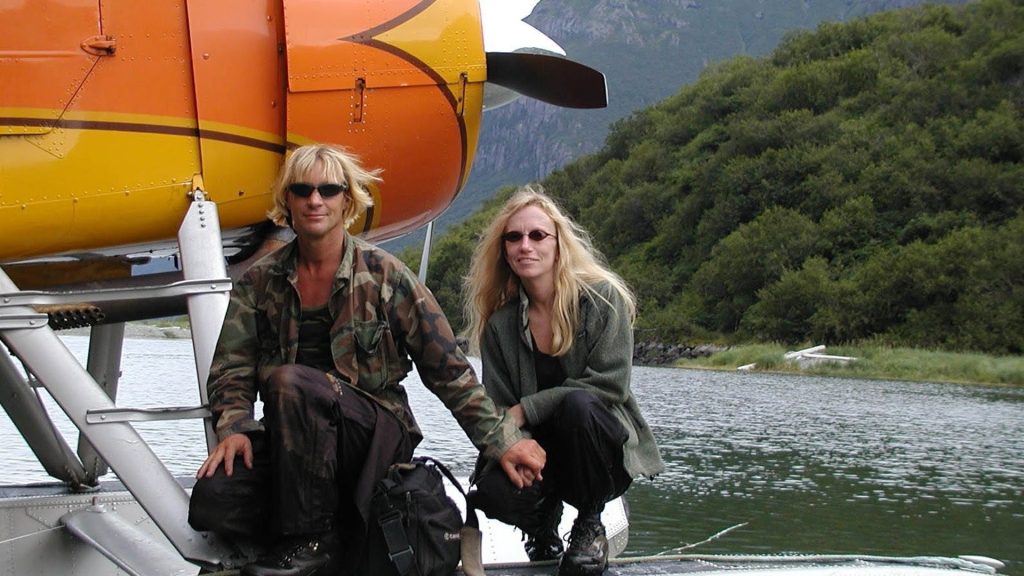Documentary filmmakers have different ideas about the proper relationship between directors and their subjects. Some like to be as unobtrusive as possible, to let their subjects’ true nature emerge. Others prefer to acknowledge their presence and explicitly frame their work as encounters with interesting people. Werner Herzog–with his trademark Teutonic, nihilistic voiceovers–prefers to make his presence known. His Grizzly Man, released 20 years ago this week, is both a poetic and infuriating dance between a lucid intelligence and a disordered, occasionally infuriating mind.
Grizzly Man tells the story of an unconventional life and meditates on its ultimate value. Timothy Treadwell was a passionate lover of grizzly bears, and a tireless, charismatic advocate for them. Treadwell’s mission was personal: for 13 years, he spent his summers living among the bears in a remote area of Alaska, ostensibly to protect them from hunters and poachers. Eventually, the seemingly inevitable happened, and Treadwell and his girlfriend, Amie Huguenard, were killed by one of his beloved grizzlies in a brutal attack. He left behind a treasure trove of footage of the bears and himself, providing both a close-up view of these creatures and an intimate look at Treadwell’s psychology.
Treadwell’s bloody end is a gripping, morbid drama, and Herzog leans into it. Treadwell’s friend tells the grisly story of discovering his remains; a well-meaning but extremely blunt coroner details exactly how horrific his and Huguenard’s deaths must have been. But Grizzly Man is primarily a character study. Herzog is drawn to the emotional, sometimes spiritual, aspects of Treadwell’s communion with grizzlies. He admires Treadwell as a filmmaker. In his videos, Treadwell captures the bears’ majesty as they amble through the grass, meander through rivers, or square off in truly thrilling displays of strength. It’s no surprise that someone this obsessed with animals might have trouble fitting into society. Treadwell had his share of travails: a failed showbiz career, alcoholism, and untreated mental health issues. Running from his demons, he sought to shed his humanity and become an animal himself. This pursuit captivates Herzog. Looking at Treadwell’s footage, he intones, “I discovered a film of human ecstasies and darkest inner turmoil.”
Yet whatever else he was, Treadwell’s sojourns could only be the project of a stunningly arrogant asshole. Herzog presents plenty of evidence that the man’s mission was, at best, misguided. Grizzly bears were not actually endangered in Alaska. A Native American museum curator explains that Treadwell violated long-standing taboos about maintaining boundaries between the human and animal worlds. But the man mostly damns himself with his own words and demeanor, in long monologues from his videos. Though he may want to protect the bears, he takes a macho pride in his ability to live, and sometimes square off with, them. If a bear gets aggressive, he says: “in a sense, you must become more powerful than the bear.” His demeanor can be excruciatingly off-putting: it’s hard to watch him brazenly bopping bears on the nose, and repeatedly cooing “I love you” to these dangerous animals in a sing-songy voice. His tirades against his “enemies”–the National Parks Services and hunters–are angry, whiny and clearly symptomatic. Even Herzog concedes that Treadwell’s directorial skills were incidental to his Rambo-esque posturing.
Herzog shows the good and the bad in equal measure, and the film excels when its director is most blatantly grappling with his feelings about Treadwell. His obsession with men driven by intense compulsions is evident in his other films, like The Great Ecstasy of Woodcarver Steiner. “I have seen this madness before on a film set,” Herzog says in response to Treadwell’s rantings. This is certainly a reference to the actor Klaus Kinski, Herzog’s frequent collaborator, who was frequently a huge pain in his ass. But Kinski’s eccentricities led to demonic performances that you couldn’t look away from. Treadwell, too, pushed himself to the edge, but with his derpy Prince Valiant haircut and constant whining, he is often someone you want to walk away from. If Herzog sometimes goes too easy on Treadwell, these are the moments where the director is wrestling with himself. He shows Treadwell warts and all, but it’s also clear that he envies his rose-tinted view of nature.
Those who love Herzog’s juicily fatalistic voiceovers will not be disappointed with Grizzly Man. He spells out with characteristic bleakness how his own philosophy differs from Treadwell’s: “I believe that the common denominator of the universe is not harmony, but chaos, hostility, and murder.” In these tensions and Herzog’s good-faith attempts to reconcile them, what emerges is a warped masculinity (both Treadwell’s and Herzog’s) that seeks meaning by intervening in forces too great to be conquered or fully grasped.
If this is hard to sit with, that is what makes Grizzly Man worth revisiting. Treadwell (anti-system, guided by his own research) is a very contemporary character: in his battle with the parks system, he is simpatico with the sovereign citizen movement. There’s also a bit of the incel about him (“I always cannot understand why girls don’t wanna be with me for a long time”). Treadwell attracted much media attention in his lifetime; one can only imagine what kind of havoc he could wreak today with a GoPro and a halfway decent social media following. If it seems hard to extend any sympathy to this kind of character, the movie does not demand it. Judgment does not preclude enlightenment; the thorny dance reveals its own secrets.
“Grizzly Man” is streaming on Amazon Prime, Kanopy, Hoopla, and several ad-supported streamers.

